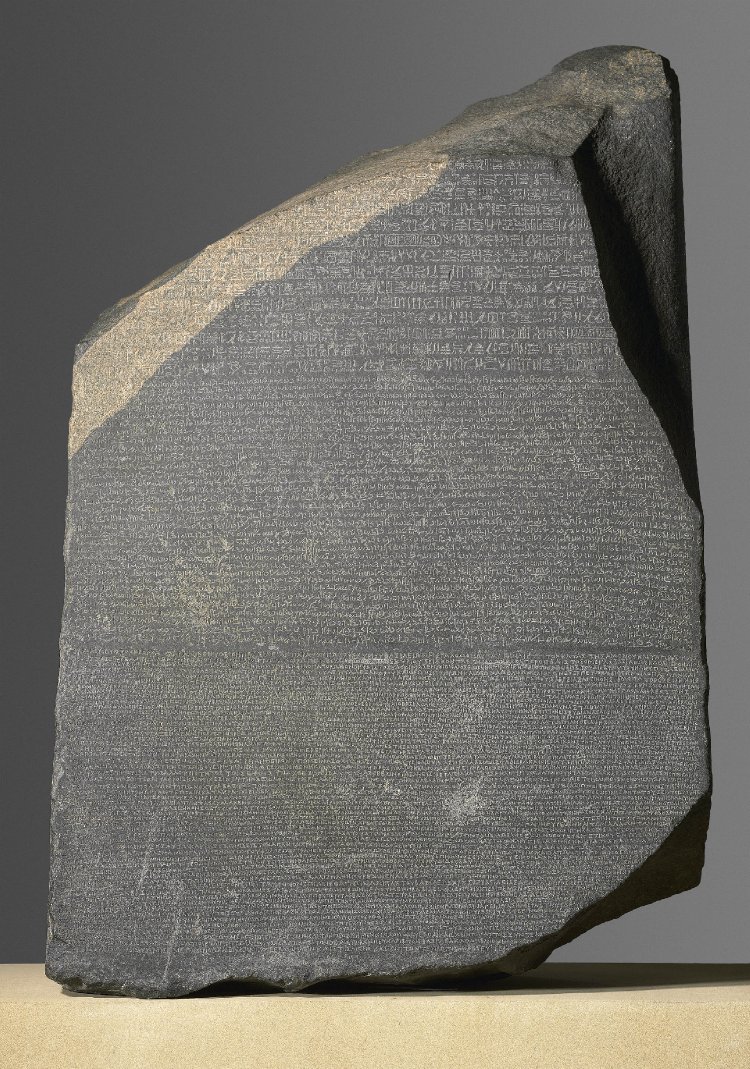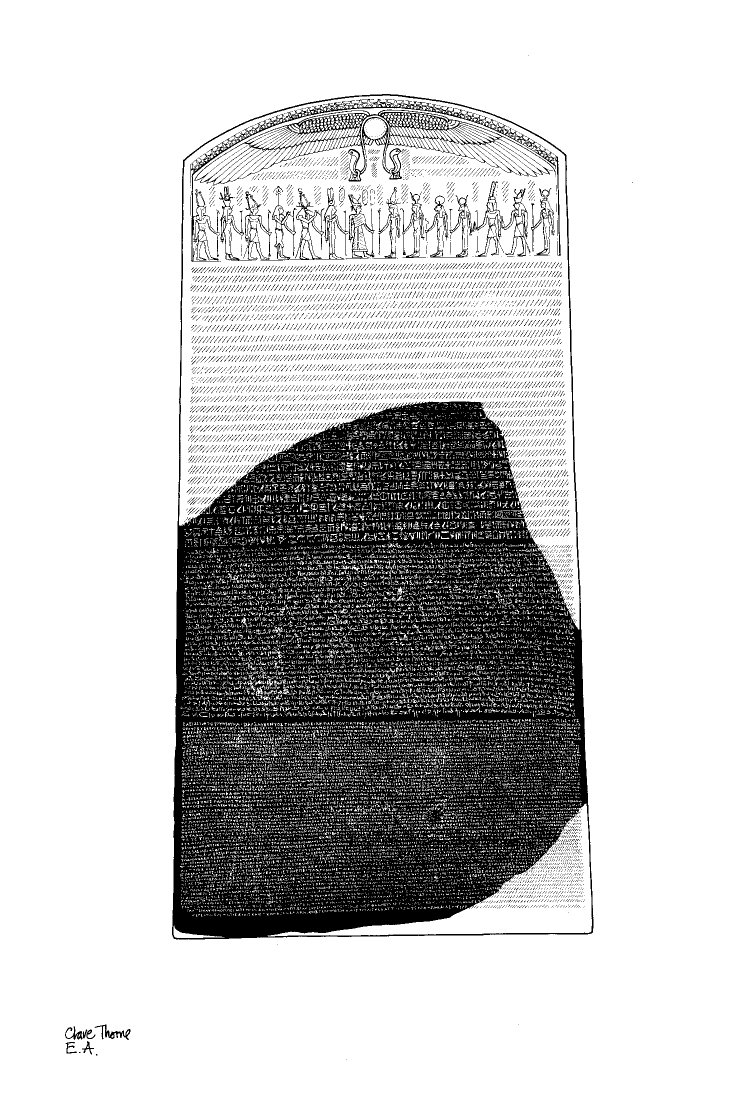The Rosetta Stone: Unlocking the Ancient Egyptian Language
The Rosetta Stone, a symbol for different things to different people, is a dark-colored granodiorite stela inscribed with the same text in three scripts – Demotic, hieroglyphic and Greek. In July 1799, the stone was found in the city of Rosetta (modern el Rashid) by French soldiers during Napoleon’s invasion of Egypt. Rosetta was located on a tributary of the Nile near the Mediterranean coast east of Alexandria. Napoleon’s forces were constructing fortifications when the large inscribed stone fragment was uncovered by officer Pierre François Xavier Bouchard (1772–1832). He immediately recognized the significance of the juxtaposed Greek and hieroglyphic scripts, predicting correctly that each script represented a translation of a single text. This guess was corroborated upon translating the Greek description of how the stela’s text was to be promulgated: “This decree shall be inscribed on a stela of hard stone in sacred (hieroglyphic), native (Demotic), and Greek characters.” Thus, the Rosetta Stone (in French “the stone of Rosetta”) was named after the city where it was discovered.
Since initially unearthed, the Rosetta Stone has become an international icon whose kaleidoscopic symbolism has been appropriated by diverse groups over the last two centuries. Its current residence in the British Museum is a legacy of the imperial ambitions of France and England in their struggle to establish, maintain and extend colonial empires in the late 18th and early 19th centuries. The stone itself still bears the marks of these conflicts as texts painted on its sides declare “captured in Egypt by the British army 1801” and “presented by king George III.” Egypt, at the time part of the Ottoman empire, found itself pinned between competing political powers. Napoleon’s invasion in 1798, and his subsequent defeat by British and Ottoman forces in 1801, led Egypt into a century often characterized by exploitation. Repression of independent development by European powers led to mass protest, widespread resistance and periodic revolt, frequently mobilized around nationalist sentiments among the predominantly Islamic and Coptic populations. The stone was officially turned over to the British in the Treaty of Alexandria in 1801, then accessioned into the British Museum in 1802. There, under registration number BM EA 24, it has remained on almost continuous display. This historical context is crucial for understanding how various communities have shaped the meaning of the Rosetta Stone.
For Napoleon’s soldiers who discovered the stone, as well as for the British soldiers who confiscated it after the French defeat, the stone represented political hegemony and scientific discovery. For many groups of Egyptians, the stone has been regarded as an emblem of a shared cultural and national heritage. As such, some individuals have framed the “export” of the Rosetta Stone as a colonial “theft” that should be assuaged through repatriation to the modern Egyptian state. Its critical role in deciphering ancient Egyptian scripts has led to the proliferation of the term “Rosetta Stone” as a generic reference to anything that decodes ciphers or reveals hidden mysteries. The business community has eagerly capitalized on this popularity, best represented by the adoption of the moniker for a successful language-learning software. “Rosetta Stone” is so ubiquitous in 21st-century global culture that future generations may one day use the phrase without understanding its origin in the chance discovery of a remarkable looking rock in Egypt.
As scholars embarked on serious attempts to decode the Egyptian scripts with the help of the Greek translation, the trilingual nature of the inscription on the Rosetta Stone set off a decipherment frenzy in Europe. Although popular imagination connects the Rosetta Stone most immediately to the Egyptian hieroglyphic script, the first significant steps toward decipherment focused on the demotic inscription since it was the best preserved of the Egyptian versions. Antoine Isaac Silvestre de Sacy (1758–1838), a French philologist, and his Swedish student Johan David Åkerblad (1763–1819), managed to identify the phonetic values for many of the so-called “alphabetic” signs, to read the personal names, and to determine the translation for a smattering of other words. The starting point for these efforts was using the personal names of the kings and queens mentioned in the Greek inscription and trying to match their sounds to characters in the Egyptian versions.
These developments set the stage for the now infamous rivalry between Thomas Young (1773–1829) and Jean-François Champollion (1790–1832) in the race to decipher Egyptian hieroglyphs. Both men were brilliant. Young, the elder by seventeen years, made incredible progress with both the hieroglyphic and demotic scripts, but it was Champollion who led the final breakthrough. Champollion had dedicated his intellectual efforts since childhood to ancient Egypt and studied Coptic under Silvestre de Sacy. These efforts paid off when Champollion confirmed the hypothesis that Egyptian hieroglyphs indicated phonetic sounds, using his knowledge of Coptic to correctly deduce the reading of the hieroglyphic writing of the word “to give birth” ( ms, Coptic ⲙⲓⲥⲉ). At this moment, he became the first person in well over a millennium to read the cartouches of Ramses and Thutmosis in their original language. In a legend recounted by Champollion’s nephew, upon recognizing the significance of this confirmation, Champollion burst into his brother’s office, shouted “I’ve got it!,” and fainted, remaining unconscious for nearly a week. With this exceptional feat, Champollion established himself as the “father” of Egyptology, embedding the Rosetta Stone into the birth of a new discipline.
With the mysteries of the Egyptian script unlocked by Champollion and his successors, scholars were able to confirm the Rosetta Stone represented three translations of a single text. The content of that text, already known from the Greek version, was a decree in the name of king Ptolemy V Epiphanes. On March 27, 196 BCE, a synod of priests from around Egypt convened to celebrate the coronation of Ptolemy V Epiphanes the previous day in the city of Memphis, the traditional capital of Egypt. At that time, Memphis had been eclipsed economically by Alexandria on the Mediterranean coast, but the city remained an important symbolic link with the pharaonic past. The royal edict stemming from this meeting was circulated on stelae throughout the country. As the congregation and coronation took place in Memphis, the text on the Rosetta Stone – and therefore sometimes the stone itself – is often referred to as the Memphis Decree. The decree is attested on several other stelae from Elephantine and Tell el Yahudiya, while select passages are paralleled on a stela from Nobaireh.
At the time the decree was written in 196 BCE, the king was just 13 years old, a teenager who received the crown at a difficult moment in the history of the Ptolemaic dynasty. The reign of Ptolemy IV (221–204 BCE) ended with widespread revolt throughout Egypt, including the establishment of a short-lived dynasty of “native” kings in Upper Egypt after 206 BCE. Part of the decree preserved on the Rosetta Stone celebrates Ptolemy V’s quelling of the delta portion of this rebellion and his supposed siege of the city of Lycopolis. Archaeological excavations at the site of Tell Timai show evidence of disturbance and disruption during this time, which the excavators have associated with the Ptolemaic suppression of the revolts. Although the young king inherited the throne at the death of his father in 204 BCE, he had taken the diadem of rulership as a toddler under the supervision of scheming regents who quickly arranged for the murder of queen Arsinoe III, leaving the young boy without a mother or family regent. As a child, Ptolemy V was crowned by the regents in the palace, but his official coronation was delayed for nine years until he grew older; this later coronation is the celebratory cause of the Memphis Decree on the Rosetta Stone. Although the delta resistance was defeated – according to the text on the Rosetta Stone – the Upper Egyptian rebels held out until 186 BCE when royal sovereignty over the region was restored.
The decree itself is a complex document attesting to the negotiation of authority between two powerful groups: the royal house of the Ptolemies and the collected associations of Egyptian priests. In the stone’s text, Ptolemy V is presented as a beneficent ruler who will renew financial support for the temples, increase priestly stipends, reduce taxes, offer amnesty for prisoners and sponsor prominent animal cults. In return, the royal cult will be reaffirmed through statues called “Ptolemy, protector of Egypt” erected in temples throughout the land. The priests are to tend to the statues three times daily and celebrate the holidays of the king’s birth (thirtieth day) and the day of his accession (seventeenth day) each month. The king’s authority is therefore continually reaffirmed, while material benefits are conferred on the Egyptian religious administration. Similar imperial pronouncements are attested on other stelae, often called the Ptolemaic sacerdotal decrees, a context into which the Memphis Decree on the Rosetta Stone must be understood. Famous examples of sacerdotal decrees include: the Mendes stela of 264/3 BCE in the reign of Ptolemy II Philadelphus; the Alexandrian decree of 243 BCE and the Canopus decree of 238 BCE in the reign of Ptolemy III Euergetes; the Raphia decree of 217 BCE in the reign of Ptolemy IV Philopator; the Memphis decree of the Rosetta Stone from 196 BCE, the first and second Philae decrees of 186–185/4 BCE, and the Nobaireh decree from 182 BCE in the reign of Ptolemy V Epiphanes. New fragments of such stelae continue to be discovered in archaeological excavations, including a new example of the Alexandrian decree from el Khazindariya found in 1999–2000 and fragments of the Canopus decree from Tell Basta found in 2004.
Recommended Reading
Carol Andrews. The Rosetta Stone. London: British Museum, 1981.
Richard Parkinson. Cracking Codes: The Rosetta Stone and Decipherment. London: British Museum, 1999.
Richard Parkinson. The Rosetta Stone. London: British Museum, 2005.
Stefan Pfeiffer. “Das Dekret von Rosette. Die ägyptischen Priester und der Herrsherkult.” In Alexandreia und das ptolemäische Ägypten: Kulturbegegnungen in hellenistischer Zeit, edited by Gregor Weber, pp. 84–108. Berlin: Verlag Antike.
Stephen Quirke and Carol Andrews. The Rosetta Stone. London: British Museum, 1988.
John Ray. The Rosetta Stone and the Rebirth of Ancient Egypt. Cambridge: Harvard University Press, 2007.
Andrew Robinson. Cracking the Egyptian Code: The Revolutionary Life of Jean-François Champollion. London: Thames & Hudson, 2012.



